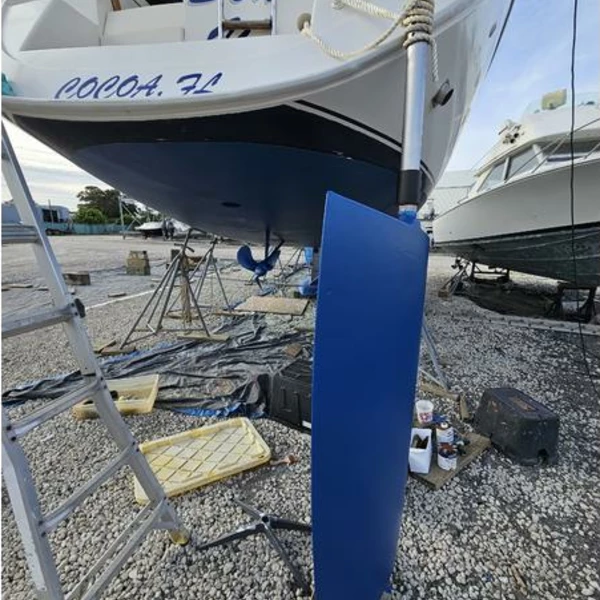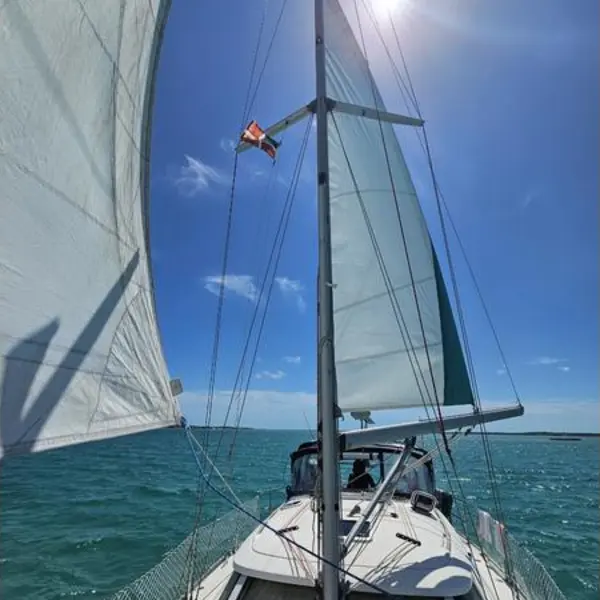Seller's Description
A drastic change in plans (we’re moving to Europe) means that we are selling our new-to-us liveaboard dream boat. We bought her in October 2023, had her in the yard for 2 months where we had: - the bottom stripped, sealed with 5 coats of Interlux 2000e followed by 5 coats of Trinidad HD; - seacocks replaced with bronze Grocos; - a new water strainer for the Yanmar installed; - a new exhaust hose installed; - the rudder pulled, repaired some chipped glass and had a new rudder bearing custom made and installed; - all hatches replaced with new Goiot hatches imported from France; - a new dashboard built with new Garmin electronics; - 600 ah of LiFePo4 installed for the house, plus a 1000W inverter; - Starlink installed on a custom mast; - 230W hard-panel solar installed on dinghy davit arch, plus 800W of flexible solar on Bimini and Dodger; - a new manual toilet and shower head installed in the v-berth head; - shower pumps rebuilt;
- original curtains replaced with custom-made drapes;
- salon sole sanded to bare wood and revarnished.
Projects we were going to address before heading to the Caribbean this fall:
-
rewire the mast and install new Garmin gWind Transducer and new masthead tricolor light;
-
replace sanitary hose in salon head (we only use that head to shower);
-
remove Force10 gas stove and replace with gimbaled induction hob (currently using single burner induction hob);
-
service built-in watermaker (we are currently using a portable watermaker).
We have been cruising The Bahamas for 3 months, and plan continuing to do so until we head back to Florida in May to sell our boat and move to Europe. It took us over a year to find this boat and waited nearly 2 months for the previous owner to bring her up from the USVIs to Florida (work prevented us going to get her). Since we know this is a boat that rarely comes on the market we want to give the same opportunity to her next owner: wait for us to bring her back to Florida or come to The Bahamas and continue cruising her here (or take her south!)
Equipment: If the offer is acceptable, we’ll include the majority of cruising equipment we have on the boat, including: SeawaterPro portable water maker (12gph) Yamaha generator Dometic 12v fridge/freezer EcoFlow solar generator 400W solar panels Bluetti solar generator 200W solar panels 4 x 100W SunPower flexible panels 9ft AB RIB plus 9.8hp Tohatsu 4-stroke
Specs
- Designers
- ?
- Builders
- ?
- Associations
- ?
- # Built
- ?
- Hull
- Monohull
- Keel
- ?
- Rudder
- ?
- Construction
- ?
Dimensions
- Length Overall
- 39′ 11″ / 12.2 m
- Waterline Length
- ?
- Beam
- 12′ 11″ / 4 m
- Draft
- 4′ 11″ / 1.5 m
- Displacement
- ?
- Ballast
- ?
Rig and Sails
- Type
- ?
- Reported Sail Area
- ?
- Total Sail Area
- ?
Mainsail
- Sail Area
- ?
- P
- ?
- E
- ?
- Air Draft
- ?
Foresail
- Sail Area
- ?
- I
- ?
- J
- ?
- Forestay Length
- ?
Auxilary Power
- Make
- ?
- Model
- ?
- HP
- ?
- Fuel Type
- ?
- Fuel Capacity
- ?
- Engine Hours
- ?
Accomodations
- Water Capacity
- ?
- Holding Tank Capacity
- ?
- Headroom
- ?
- Cabins
- 2
Calculations
- Hull Speed
- ?
Hull Speed
The theoretical maximum speed that a displacement hull can move efficiently through the water is determined by it's waterline length and displacement. It may be unable to reach this speed if the boat is underpowered or heavily loaded, though it may exceed this speed given enough power. Read more.
Formula
Classic hull speed formula:
Hull Speed = 1.34 x √LWL
A more accurate formula devised by Dave Gerr in The Propeller Handbook replaces the Speed/Length ratio constant of 1.34 with a calculation based on the Displacement/Length ratio.
Max Speed/Length ratio = 8.26 ÷ Displacement/Length ratio.311
Hull Speed = Max Speed/Length ratio x √LWL
- Sail Area/Displacement
- ?
Sail Area / Displacement Ratio
A measure of the power of the sails relative to the weight of the boat. The higher the number, the higher the performance, but the harder the boat will be to handle. This ratio is a "non-dimensional" value that facilitates comparisons between boats of different types and sizes. Read more.
Formula
SA/D = SA ÷ (D ÷ 64)2/3
- SA: Sail area in square feet, derived by adding the mainsail area to 100% of the foretriangle area (the lateral area above the deck between the mast and the forestay).
- D: Displacement in pounds.
- Ballast/Displacement
- ?
Ballast / Displacement Ratio
A measure of the stability of a boat's hull that suggests how well a monohull will stand up to its sails. The ballast displacement ratio indicates how much of the weight of a boat is placed for maximum stability against capsizing and is an indicator of stiffness and resistance to capsize.
Formula
Ballast / Displacement * 100
- Displacement/Length
- ?
Displacement / Length Ratio
A measure of the weight of the boat relative to it's length at the waterline. The higher a boat’s D/L ratio, the more easily it will carry a load and the more comfortable its motion will be. The lower a boat's ratio is, the less power it takes to drive the boat to its nominal hull speed or beyond. Read more.
Formula
D/L = (D ÷ 2240) ÷ (0.01 x LWL)³
- D: Displacement of the boat in pounds.
- LWL: Waterline length in feet
- Comfort Ratio
- ?
Comfort Ratio
This ratio assess how quickly and abruptly a boat’s hull reacts to waves in a significant seaway, these being the elements of a boat’s motion most likely to cause seasickness. Read more.
Formula
Comfort ratio = D ÷ (.65 x (.7 LWL + .3 LOA) x Beam1.33)
- D: Displacement of the boat in pounds
- LWL: Waterline length in feet
- LOA: Length overall in feet
- Beam: Width of boat at the widest point in feet
- Capsize Screening
- ?
Capsize Screening Formula
This formula attempts to indicate whether a given boat might be too wide and light to readily right itself after being overturned in extreme conditions. Read more.
Formula
CSV = Beam ÷ ³√(D / 64)
- Beam: Width of boat at the widest point in feet
- D: Displacement of the boat in pounds
This listing is presented by SailboatListings.com. Visit their website for more information or to contact the seller.




















